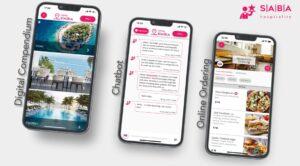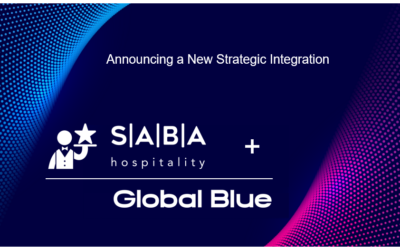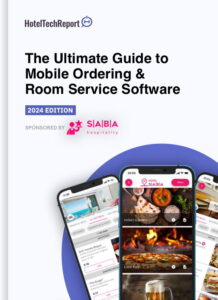In 2006, Tourism Australia launched an advertising campaign which coined the phrase ‘So where the bloody hell are you?’. Most hoteliers will have been asking themselves that same question over the last two years, albeit with slightly less Australian flavour on the language. After 2 years of the pandemic, the appetite for travel is insatiable. And while the guests are returning, and occupancy levels rising, staff are scarce, with many operators now struggling to maintain service standards with what can only be described as a decimated workforce. Many are taking extraordinary measures such as closing restaurants, reducing room numbers, or removing services. Not because the demand isn’t there, but because there are no staff to service this demand. So, while operators ponder the question of ‘where the bloody hell are you?’ as it relates to labour, how can hoteliers provide a high-level guest journey, with fewer resources, and less money? Because as Albert Einstein, one of history’s great thinkers says, “In the middle of difficulty lies opportunity”.
The answer can lie in automation through the use of technology. And luckily, it not only provides a short-term band-aid to the existing challenges facing the industry, but it provides hoteliers an opportunity to transform their businesses for years to come and better service the needs of their customers in a more cost effective and efficient manner. According to McKinsey1, the pandemic accelerated digital transformation in hospitality by 10 years. And those with foresight will take advantage and position themselves for the future. In a fantastic article by Max Starkov titled No, Guests Do Not Require Human-Provided Services In Hospitality , Hilton CEO Chris Nassetta was referenced as quoting “The work we’re doing right now in every one of our brands is about making them higher-margin businesses and creating more labor efficiencies, particularly in the areas of housekeeping, food and beverage, and other areas….When we get out of the crisis, our brands will be higher margin and require less labour than they did pre-COVID.” And that’s what leaders do. That’s how innovators think. They seize opportunities for what they are and use them to their advantage.
For hoteliers, implementation of a digital guest journey not only provides significant opportunity to automate the guest experience at multiple guest touch points, but it supports a contactless stay, meets the modern travelers’ expectations around self-service and do-it-yourself, and can take significant load of frontline staff. But given technology (cloud, mobility, AI, and IoT) can be used to automate almost any task, where should you begin? This is especially pertinent given the cost of automation can be quite capital intensive, which may not be feasible for many operators in today’s climate (although the long term labor savings would more than justify the implementation of many technologies).
A good place to begin is with technology that is cost effective, easy to implement, but has the capacity to significantly enhance the guest journey, and remove repetitive tasks from frontline staff, freeing them up to engage in more high-value interactions. To that end, the following provides a nice starting point:
- Digital Compendiums
Highly engaging, quick and easy to implement (most properties already have all the content), don’t require constant cleaning, and can live with guests throughout their entire journey. Digitizing your compendium and offering it to guests via their own mobile device is something all properties can do without additional capital expenditure. And information can be altered in real-time, meaning guests will always have the most up-to-date information available in their hands, 24 hours a day. An added bonus, you can link up existing systems such as table management and spa booking platforms and enhance the value of infrastructure that has already been implemented.
- Digital Ordering
Touchless ordering became the norm during the pandemic. For many, it was already their preferred way to order a meal, or purchase goods and services. It’s convenient, easy and allows operators to streamline room service, poolside ordering or hotel shop purchases with minimal human interaction. And with greater convenience, and the ability to build in powerful up-sell mechanics, average check values can often rise by as much as 20%. And that’s before considering the savings associated with the printing of menus and other promotional collateral. Digital ordering should already have been on operators radar, the pandemic has now made it an essential service.
- Chatbots: aka the Virtual concierge
Let’s be clear here: nothing beats a little human to human contact. But automated assistants, such as a virtual concierge, can provide a plethora of services that put guests in control of when and where they interact with staff. Chatbots can place a plethora of hotel and destination information in the guests’ hands 24/7, and answer pretty much any question about your property and its services. It can also automate other processes such as amenity requests, reservations and be a valuable tool for collecting real-time guest feedback. And with the capability to be manage interactions in multiple languages, chatbots can provide a level of personalization that greatly enhances the overall guest experience.
- Online Check-in and Keyless Entry
Ok, so we’ve covered the basics that all hoteliers should be looking at implementing as soon as possible. For those with the appetite (and the budget) to take on more complex automation projects, allowing guests to bypass reception via online check-in and keyless entry will solve a large pain point for guests (the front desk), while removing significant load off front-line staff. Yes, the investment in digital keys can be more significant, but allowing guests to take control of their journey, and empowering them to use their own devices to drive that digital experience, offers a unique opportunity for operators to position themselves at the forefront of modern traveler expectations, while simultaneously managing their exposure to the impacts of labor uncertainties over the short, medium and long term.

So, there you have it, a few suggestions to get you started on the implementation of your new digital guest journey. And while all properties are different, and are at different stages of their digital transformation, its essential to appreciate that the current environment provides an opportunity. The goal inflicted upon hoteliers in the current environment is simple: do more with less, by embracing technology and thus reducing a properties reliance on physical labor. And it’s a goal that needs to be embraced, not avoided. And on that note, I’ll leave you with this. A thought from one of the great motivators of the modern era, Tony Robins:
“Expect change. Analyse the landscape. Take the opportunities. Stop being the chess piece; become the player. It’s your move.”
References:
1: McKinsey: https://www.mckinsey.com/business-functions/strategy-and-corporate-finance/our-insights/five-fifty-the-quickening





0 Comments